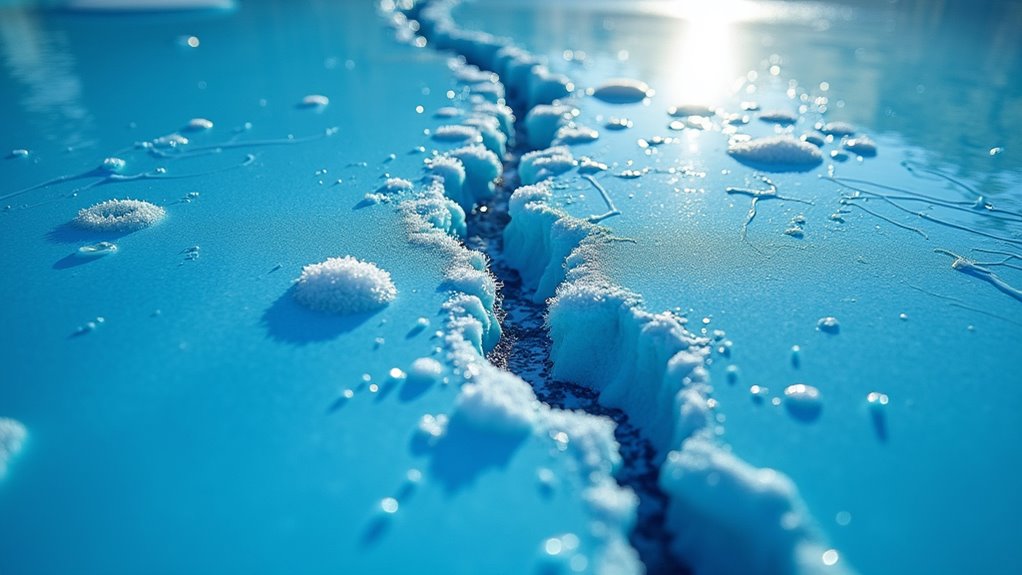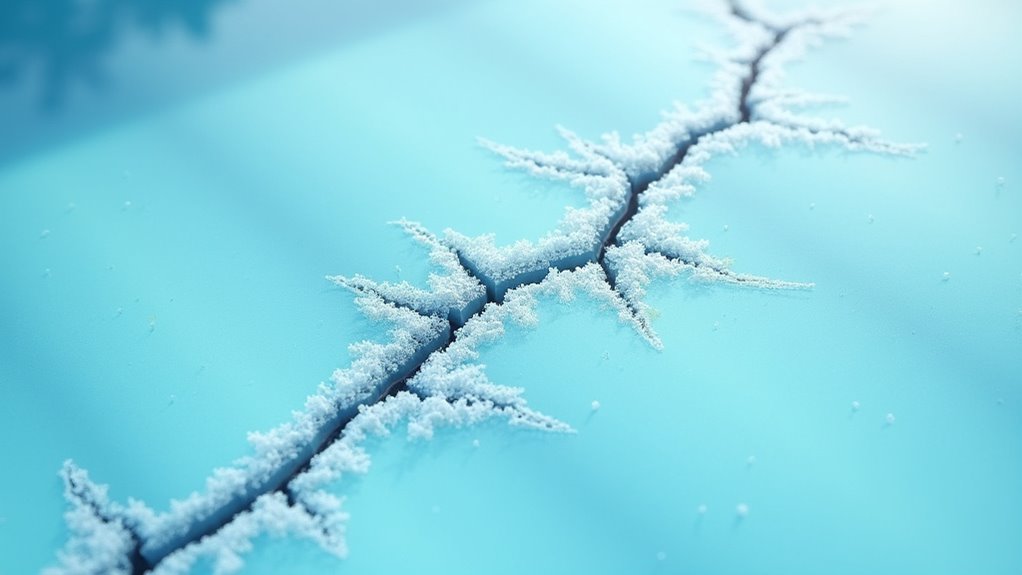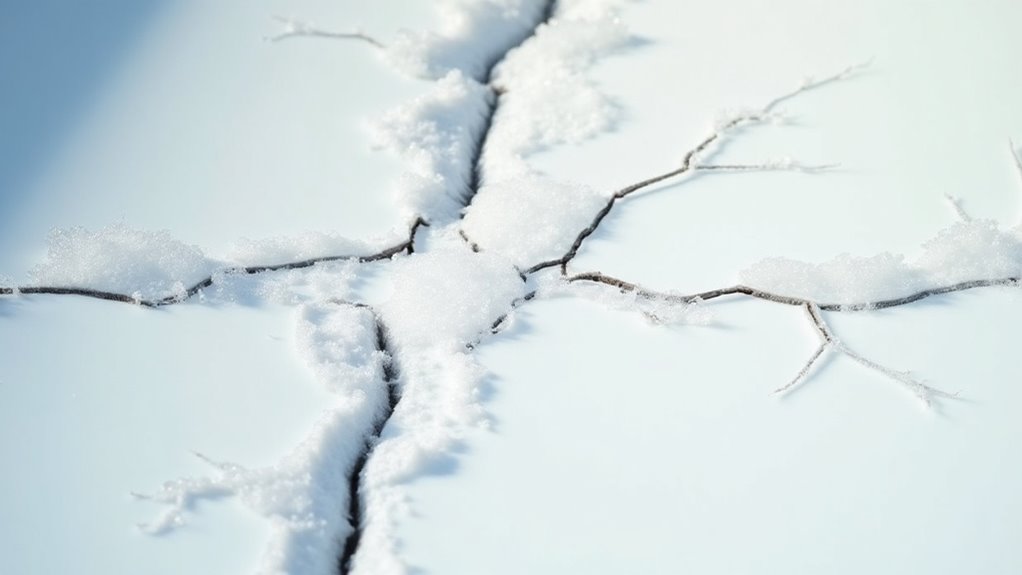Cold weather can crack your fiberglass pool through multiple mechanisms. When water freezes, it expands by 9%, creating pressure exceeding 2,000 pounds per square inch against your pool’s walls. This force, combined with freeze-thaw cycles, produces hairline cracks along the waterline and spider-web patterns near fittings and corners. You’ll also face stress from different thermal expansion rates where materials meet, plus soil movement from frost heave. Understanding these specific damage patterns helps prevent catastrophic failures.
Key Takeaways
- Water expands by 9% when freezing, creating intense pressure that can cause hairline cracks along the pool’s waterline.
- Repeated freeze-thaw cycles weaken the bond between gel coat and structural layers, leading to delamination and cracking.
- Ice formation concentrates stress at material junctions, particularly where steps connect to the main pool shell.
- Freezing soil expansion exerts pressure on pool walls, potentially causing structural cracks and shell warping.
- Temperature fluctuations create differential expansion rates between materials, stressing corners and fittings until cracks form.
Understanding the Science Behind Freezing Water in Pools

When water temperature approaches 32°F (0°C), its molecules begin to slow down and form crystalline structures, creating a unique phenomenon that affects pools differently than most other liquids. Unlike most substances that contract when frozen, water expands by approximately 9% during the freezing process, exerting significant pressure on surrounding surfaces.
You’ll find that this thermal expansion can create forces exceeding 2,000 pounds per square inch – powerful enough to damage pool structures. Water chemistry plays a vital role in this process, as dissolved minerals and chemicals can alter the freezing point and crystallization patterns. When water freezes in your pool, it doesn’t do so uniformly; instead, it forms from the surface downward, creating a layer of ice that can trap and pressurize the remaining liquid water below.
Common Cold Weather Damage Patterns in Fiberglass Pools

The freezing behavior of pool water directly manifests in several identifiable damage patterns specific to fiberglass pools. You’ll notice hairline cracks forming primarily along the waterline, where ice expansion exerts the most pressure against the shell. Despite the inherent fiberglass durability, these stress points can develop into spider-web patterns, particularly in corners and around fittings.
The pool’s temperature resilience becomes compromised when repeated freeze-thaw cycles create delamination between the gel coat and structural layers. You’ll observe bulging or bubbling in the surface, indicating separation of these critical components. In severe cases, you may detect structural cracks extending from the coping downward, or witness displacement at the skimmer joints where ice formation has disrupted the seal integrity.
Critical Stress Points During Temperature Fluctuations

During extreme temperature shifts, fiberglass pools experience concentrated stress at specific structural junctions where different materials meet. You’ll find these critical points where your pool’s steps connect to the main shell, at the bond between the coping and pool wall, and around skimmer openings.
Thermal expansion rates differ between fiberglass, concrete, and metal components, creating zones of intense pressure. When temperatures plummet, you’ll notice stress distribution patterns focusing primarily at these connection points. The shell’s top edge bears significant strain due to its exposure to both air and water temperatures, while the plumbing penetrations often become focal points for structural tension. Your pool’s corners and radius transformations are particularly vulnerable, as they must absorb movement from multiple directions during freeze-thaw cycles.
Soil Movement and Its Effect on Pool Structure
As temperatures drop and soil moisture levels fluctuate, ground movement around your fiberglass pool can create significant structural challenges. When water in the soil freezes, soil expansion occurs, exerting pressure against your pool’s walls. This pressure isn’t uniform, which can compromise your pool’s stability and structural integrity.
You’ll notice that different soil types react distinctively to freezing conditions. Clay soils are particularly problematic, as they’re prone to dramatic expansion and contraction cycles. These cycles can force your pool to shift, potentially causing misalignment or warping of the shell. To maintain pool stability, you’ll need proper drainage systems and carefully engineered backfill materials that minimize frost heave effects. Furthermore, you should monitor the soil conditions around your pool during winter months to detect early signs of problematic ground movement.
Signs of Cold Weather Damage to Watch For
Regular inspection of your fiberglass pool becomes particularly essential when monitoring for cold weather damage. You’ll need to watch for specific indicators that signal potential structural compromise. Look for hairline cracks along the pool’s walls and floor, especially near water lines and corners where stress concentrates. Check for any delamination or bulging of the gel coat, which often appears as bubbling or separation of layers.
For effective crack prevention, monitor your pool’s structural integrity when temperatures drop below freezing. Pay attention to any unusual sounds, like creaking or popping, during temperature fluctuations. You should also examine the coping and tile work for signs of separation or movement. If you notice water seepage around the pool’s perimeter or unexplained water loss, these could indicate developing structural issues requiring immediate attention.
Winterization Techniques to Prevent Cracking
While winter’s freezing temperatures pose significant risks to fiberglass pools, proper winterization techniques can effectively prevent structural damage and cracking. Your winter poolization process should begin by lowering the water level to just below the skimmer line, but never drain the pool completely. You’ll need to add specialized pool antifreeze to your plumbing lines and properly blow out all water using compressed air. Additionally, Secure equipment and use a durable, insulated cover to guard against harsh weather. Winterizing fiberglass pools protects the structure and ensures an easy spring opening; check the cover regularly for debris or damage.
Install freeze prevention devices like ice compensators or “gizzmos” in your skimmers to absorb ice expansion. You should also maintain proper chemical balance before closing, with slightly higher chlorine levels to prevent algae growth. Ultimately, secure a high-quality winter cover that fits tightly across your pool’s surface, preventing debris accumulation and maintaining consistent temperatures throughout the cold season.
Professional Maintenance Strategies for Cold Climates
Professional maintenance in cold climates requires a systematic approach that extends beyond basic winterization protocols. You’ll need to implement rigorous maintenance schedules and monitor pool chemicals throughout the cold season, even when your pool isn’t in use.
- Conduct bi-weekly water chemistry tests to maintain proper pH and alkalinity levels, preventing chemical imbalances that can weaken fiberglass surfaces
- Schedule professional inspections of structural components, including shell integrity and plumbing systems, before and after extreme temperature drops
- Install automated monitoring systems to track water levels and temperature fluctuations, enabling quick responses to potential issues
- Document all maintenance activities and chemical adjustments in a detailed log to establish patterns and optimize future winterization strategies
These proactive measures help prevent costly repairs and extend your fiberglass pool’s lifespan in challenging cold climate conditions.
Repair Options for Cold Weather-Related Damage
Despite proper maintenance protocols, fiberglass pools can sustain multiple forms of cold weather damage that require specific repair strategies. When you identify cracks or delamination, you’ll need to implement specialized repair techniques customized to cold-weather conditions. Use materials that withstand freezing temperatures and take preventative steps like winterizing your pool. Protecting fiberglass pools in winter preserves their lifespan and helps avoid costly spring repairs.
For hairline cracks, you can apply epoxy-based fillers designed for low-temperature curing. If you’re dealing with larger fissures, you’ll need to use reinforced patching systems that incorporate fiberglass matting and cold-weather compatible resins. Material selection is vital – standard repair compounds often fail in freezing conditions, so you’ll want to choose products specifically formulated for temperatures below 50°F.
You can address surface blistering through careful grinding and refinishing, while structural damage may require professional injection systems that maintain viscosity in cold environments.
Frequently Asked Questions
Can I Install a Fiberglass Pool in Areas With Extreme Winter Conditions?
You can install a fiberglass pool in cold climates, but you’ll face specific installation challenges and winter maintenance requirements. You’ll need proper ground preparation, including adequate drainage systems and precise backfilling techniques. You must maintain consistent water levels and use a winter cover to prevent structural stress. It’s crucial to winterize your pool correctly, including balancing chemicals and protecting plumbing systems from freezing temperatures.
How Long Do Fiberglass Pools Typically Last in Cold Climate Regions?
When properly maintained, you can expect your fiberglass pool’s longevity to reach 25-35 years in cold climate regions. The inherent flexibility and durability of fiberglass allows it to withstand freeze-thaw cycles better than concrete pools. You’ll need to guarantee proper winterization, maintain water chemistry, and monitor the shell’s integrity annually. With premium manufacturing and professional installation, some fiberglass pools have demonstrated cold climate durability extending beyond 40 years.
Does Pool Color Affect Heat Absorption and Cold Weather Resistance?
Your pool’s color markedly influences its heat retention capabilities. Darker colors like deep blue, gray, and black absorb and retain more solar energy, potentially raising water temperatures by 2-3°F compared to lighter shades. However, color variations don’t directly impact cold weather resistance in fiberglass pools. While darker pools warm up faster and maintain heat longer during swimming season, the color won’t affect the structural integrity during freezing conditions.
Are Indoor Fiberglass Pools Also Susceptible to Cold Weather Damage?
Indoor fiberglass pools aren’t completely immune to cold weather damage, though they face fewer risks than outdoor pools. You’ll still need proper indoor pool maintenance, including maintaining consistent air and water temperatures to prevent thermal stress. Even in climate-controlled environments, you should implement winter pool precautions like monitoring humidity levels and keeping the structure above freezing, as extreme temperature fluctuations can affect the fiberglass shell’s structural integrity.
What Insurance Coverage Options Exist for Cold Weather Damage to Fiberglass Pools?
You’ll want to check your homeowner’s insurance policy carefully, as coverage for fiberglass pool damage varies greatly between providers. Standard policies often include basic structural damage, but you’ll need to verify specific coverage limits for freeze-related issues. Consider adding a pool endorsement to expand protection. When filing insurance claims, document all cold weather damage thoroughly with photos and professional assessments to enhance your reimbursement potential.






